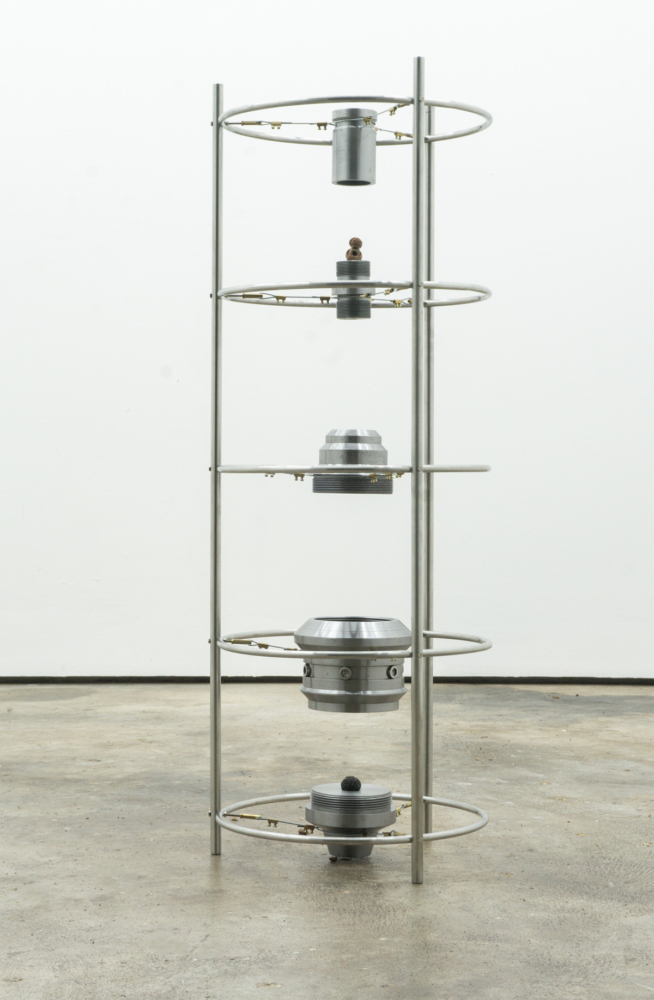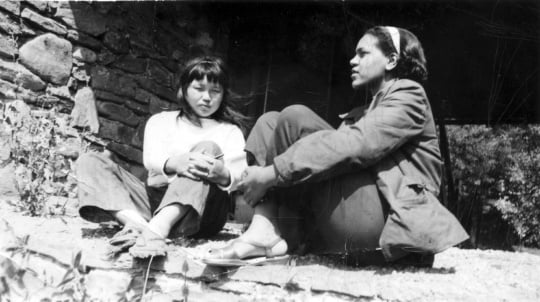
Steel lathe-turned vessels, charms made from silver metal coins, and an old work shirt adorned with perky coin nipples populate AN ANGLE GRINDER GRINDS IN THE BACKGROUND at Coco Hunday in Tampa, Florida. The included works were fabricated in Ecuadorian artist and designer Alfredo Ramírez Raymond’s multi-generational family metal shop that was recently made obsolete by automatic fabrication. The sculptures work against the grain of the bewildering, wanton destruction of accelerating modernization—imagining new possibilities for handcraft.
The metal shop, which gestures towards the primordial echo of industry, is reimagined by Ramírez Raymond for an alternative purpose: a meeting place and catalyst for collaborations with artists Rafaela Armendaris Parducci, Lucas Neira Frank, and Karin Iturralde Nurnberg. In each set of hands, the lathes, grinders, and threaders ask different questions and produce different answers.
For Armendaris: What would it look like to turn these abandoned tools—themselves formerly agents of displacement—towards the task of protecting and preserving craft? Sort of dystopian, it turns out: A small, inquisitive clay figurine pops out of a symmetrical carbon steel urn in No somos tan ancestrales (We are not that ancestral) (2022). The little lady is joined by a dark ball of earth, both replicas of ancient Chorrera artifacts discovered by Armedaris’ great aunt. The relics are suspended in a column of five lathe-turned metal cylinders that hover in the air, suspended by a steel frame that gives the impression of an exploded-view diagram of an engine or joint. Screwed together, the metal components form a 28-pound protective vessel. Like the abandoned coal mine hiding seeds deep inside a mountain in Svalbard[1], the fortification points less towards a redemptive symbiosis between cold steel and soft earth, and more towards a powerful threat on the horizon. This awesome force, ironically, is often negligence—and Armendaris’ overprotective gesture acknowledges the blind destruction of cultural heritage caused by the rerouting of funds from cultural preservation to more capital-friendly causes, especially prevalent in Ecuador.

The exhibition succeeds by triangulating each proposition against others—and the speculative pessimism of No somos tan ancestrales reverberates against sleek, hi-fi lathe-turned objects that stake a claim for industrial metal work as craft in its own right. In Para los papás que nos llevaban al karting (For the fathers who used to take us to see kart races) (2022), Ramírez Raymond’s collaboration with industrial designer Neira Frank, the medium is sentimental, memorializing the culture of petro-masculinity created by the 1972 boom in Ecuador’s oil industry. A curious silver pot perched on a copper disc drips shiny motor oil into a shallow moat and onto the floor below—sweat, tears, or slow-moving hourglass sand. Exhibition text by Juan Felipe Paredes (one half of curatorial project juniin, with Cocohunday co-director Libbi Ponce), explains the subsidization of domestic petroleum, which spurred radical economic growth and drew rural communities into urban centers. Local shipment and transportation exploded in Ecuador, and car ownership was elevated to a symbol of urban success. Against the background of seismic economic and political reorganization, the pleasure and aggressive adrenaline of motorsport and the dream of social mobility are wistfully remembered by Para los papas. The pot, suspended at chest-height by tense ratchet straps, is both an offering steeped in memory and an effigy of a culture that ambivalently draws on the speed and excess of environmental exploitation.

Contrasting the hard-edge, polished vessels are Ramírez Raymond’s collaboration with Iturralde—a more provisional, or precarious, set of five delicate sculptures crafted from American and Ecuadorian coins. Funny and informal, like an inside joke, they include Orejita con arete (Little ear with earring) (2023), a spherical charm made from cut and rotated coins hanging from a car rearview mirror by a thin, twisted rope of threaded pennies. There’s also a set of monogrammed friendship rings cut from half-dollars and a nickel-and-copper stick bug that recalls Lygia Clark’s Bichos. These hinged metal “animal” structures, like the exhibition itself, use collaboration and variability to open a universe of permutation. A counterpoint to the technical feeling of the lathe-turned objects, these works are crafts for adornment, friendship, or luck that are obviously handmade.
Existing in central Florida during the hottest month of the hottest summer of the hottest year on Earth, every passing second feels like now but also like then, existentially apocalyptic, already in the past tense. I felt the weight of this sensation as I peered into the rearview mirror, buried beneath the weight of every man-made object there ever was conspiring to boil the atmosphere as the orejita dangled mid-air.
If it could speak, the lathe in Ramírez Raymond’s shop might contribute its own end-of-the-world story. Companions to craftspeople for thousands of years, lathes were combined with steam power in the eighteenth-century. Uniquely capable of churning out uniform screws, machine lathes became necessary for the invention of all other machine tools, which went on to pulverize their way through handcraft until, unsatisfied, automated production cannibalized the lathe itself and replaced it with CNC machines. What now? Ramírez Raymond builds his future from the near past, propping open the door to a quickly eclipsing world with the sound of lathes whirring and angle grinders grinding.

[1] The Svalbard Global Seed Vault stores more than a million seed samples from around the world in a complex that extends beneath a mountain on the island of Spitsbergen. The vault aims to protect crop diversity against various potential natural and political disasters. <https://www.seedvault.no>




